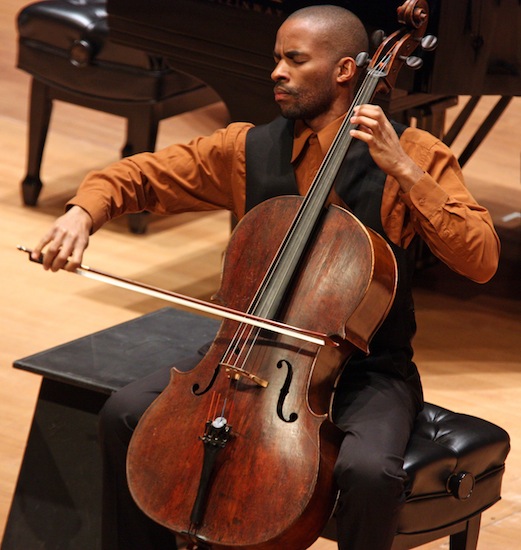AXIOM’s young musicians serve Berio’s music with sterling virtuosity

Khari Joyner performed Luciano Berio’s “Sequenza XIV” in the AXIOM concert Friday night at Alice Tully Hall. Photo: Hiroyuki Ito
The overall virtuosity of the current generation of young classical musicians is easy to take for granted. In new music circles, especially, it seems that everyone has advanced technique and the élan that comes from applying it to music that demands the most from the player. At the very least, everything is extremely well played.
Friday night at Alice Tully Hall, AXIOM, Juilliard’s premiere new music ensemble, played a concert that was a celebration of virtuosity, and it was a pleasure hearing highly skilled musicians performing music they found involving and exciting.
The gratifications began with the sole composer represented on the program, Luciano Berio. Berio, who taught at Juilliard from 1965 to 1971, was a titan of post-WWII composition. The program alone was a satisfying reminder of how wonderful his music is.
An entire series of pieces he made, the Sequenzas, deliberately pushed at the edge of what musicians were capable of. The concert featured two of these instrumental solos, Sequenza I for flute and Sequenza XIV for cello. The other two pieces were for ensemble with a prominent soloist, Folk Songs and ”points on the curve to find…”.
Berio wrote all this with some of the finest musicians of his era in mind—flutist Severino Gazzelloni, cellist Rohan de Saram, soprano Cathy Berberian, and pianist Anthony di Bonaventura. The students playing Friday ranged from an undergrad to a DMA candidate: flutist Giorgio Consolati, cellist Khari Joyner, soprano Kady Evanyshyn, and pianist Tengku Irfan.
As the concert went on, one began to think that if there were any gap between these young players and the original dedicatees, it was only in the seasoning that life experiences, good and bad, come with time and age.
Consolati began with Sequenza I. The rapid-fire octave leaps, runs, shifting articulations, and uneven intervals are emblematic of its time, 1958. Consolati played with full, strong tone, exacting articulation, and interpretive intelligence.
Flute music by Bach and Handel demands agile fingers and good breath support. But rapidly changing music–chromatic and atonal, and irregularly rhythmic–requires constant mental sharpness, the ability to look ahead while in the middle of complex passages. Consolati played with an agile mind, expressing his ideas about the music through the shape of his phrases and the way he vigorously drove through each line.
The other work on the first half was Folk Songs, Berio’s reworking of songs (folk and otherwise) from all over the world. Here the emphasis is on pure lyricism—including Berio’s own melodies to two Italian lyrics—with accompaniment that is, modern, beautiful, and almost ascetic.
For Folk Songs, the soprano has to do what Berberian could do, balance classical technique and sound (especially the size and shape of tone and vibrato) with blunter ideas about phrasing, articulation, and rhythm. Kady Evanyshyn sang with a lovely, dramatic voice—with perhaps a bit more art song aesthetic than might be absolutely ideal—and though she was in a rush at the start of the slow and melancholy “Black is the Color” it was a fine performance overall.
With colorful, sensitive, delicate accompaniment from the ensemble, conducted by Jeffrey Milarsky, Evanyshyn had the spirit of the music in her, from extremes of delicacy to vivacious extroversion in “Ballo” and “Lo fiolaire.”
Khari Joyner is one of the most exciting young musicians on the classical scene, and he turned in yet another exceptional performance with the Sequenza XIV. In this solo, the cellist spends as much time rolling out rhythms with his hands on the body of the instrument as he does plucking the strings and using the bow. Joyner played with brilliant musical charisma, the feeling that every note is meaningful and that playing music is the most important thing in the world.
He gets a rich sound out of the cello that is even across the range from fortissimo to harmonics. Coupled with his perfect intonation, he made Berio’s complex ideas sound marvelously clear, almost song-like. The rhythms he rapped out with his hands were as musical as can be.
The evocative title of “points on a curve to find…” is also descriptive. With the piano in the lead, the piece comes out of a series of monophonic lines made out of pointillist writing, something like breaking down the analog flow of music and sound into discrete, digitized components.
This is essentially a concerto, and the instruments echo and follow the piano, making what can sound like a chase along a curve. The piano part is exhausting, a stream of trills and tremolos all over the keyboard at every dynamic level, and the pianist opens the piece and plays almost nonstop until the very end, which is a sustained note held on an open string.
Tengku Irfan was inexhaustible, and the energy and clarity of his playing were dazzling. On paper, this is an exciting piece, the obsessive linearity hurtling musicians and listeners along. That energy was there, but so were surprising balance problems in the normally dry hall, the ensemble sometimes swamping the piano, the flutes often completely inaudible. That was the only flaw in an otherwise impressive and memorable concert.
AXIOM will play Hans Abrahamsen’s Schnee for their final concert of the season, 7:30 p.m. February 2. events.juilliard.edu






